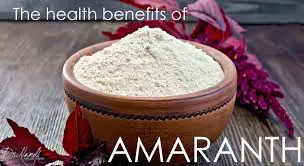The history of Amaranth dates back 8,000 years to the Aztecs and the Yucatan Peninsula and is still being eaten today. In Peru, it is a native crop found in Africa, China, Russia, and South America. Amaranth, in recent years, has started to emerge again in North America. Amaranth is gluten-free and is considered a grain. Some nutritionists believe Amaranth is a “pseudo-cereal” because it is not technically a grain like oats or wheat.
Amaranth Contains Protein
Amaranth has a high protein content. Amaranth has roughly 26 grams of protein per cup, much higher than most other grains. If you were to compare long-grain white rice to Amaranth, the rice only contains half of the protein of Amaranth. Plus, it contains lysine, which is an essential amino acid. The body does not make lysine. Therefore, it must come from food or supplements. Amino acids like lysine are the building blocks of protein. Lysine is essential for proper growth. It plays a critical role in the production of carnitine, a nutrient responsible for converting fatty acids into energy and helping lower cholesterol.
Amaranth is Heart Healthy
Research has found that Amaranth can be beneficial in reducing harmful cholesterol levels. One study found that the oil found in Amaranth may lower total and LDL cholesterol. Chickens were used in the study, but other test subjects were also being tested. A study performed in Guelph, Canada, found that Amaranth contains phytosterols known to have cholesterol-lowering properties. Phytosterols are sterols found in plants. Phytosterols and cholesterol are quite similar in structure, so much that they are absorbed through the exact mechanisms. Research suggests that you absorb less cholesterol when your diet is high in phytosterols.
Amaranth Is Good for Digestive Health
Amaranth has long been known as a great way to keep your bowels moving well. Nutritionists have found that one uncooked cup of Amaranth contains nearly 13 grams of dietary fiber. A cup of uncooked long-grain white rice only contains 2 grams of fiber.
Fiber includes the parts of plant foods your body can’t digest or absorb. Unlike lipids, proteins, or carbs, fiber is broken down and absorbed by the body. Instead, it passes relatively intact through your stomach, small intestine, and colon and out of your body. Research shows that fiber helps regulate bowel motions, reduce cholesterol, control blood sugar levels and maintain a healthy weight, according to most experts.
Amaranth Is a Vitamin Powerhouse
Studies have found that Amaranth is the only grain with a vitamin C content. The grain contains 105% of the daily value per serving of manganese. Manganese is
essential for bone production and bone health. Manganese also helps control blood sugar levels, skin health, and protection against free radical damage. Amaranth contains an ample supply of calcium, a mineral known for helping the muscles work properly and forming the structure of bones and teeth. Amaranth contains high magnesium levels, an enzyme known for protein synthesis, muscle and nerve function, blood glucose control, and blood pressure regulation. If you are adding more potassium to your diet, add Amaranth. Low potassium has been found through many studies to be associated with the risk of heart disease, stroke, cancer, infertility, high blood pressure, and others.
Because Amaranth contains a relatively high amount of oxalic acid, it should be eaten in moderation by those with gout, kidney disorders, or rheumatoid arthritis. Many nutritionists suggest not reheating Amaranth because the nitrates in the leaves can be converted to nitrites.












 Subscribe to Ask Dr. Nandi YouTube Channel
Subscribe to Ask Dr. Nandi YouTube Channel










